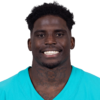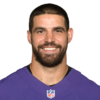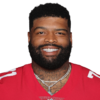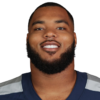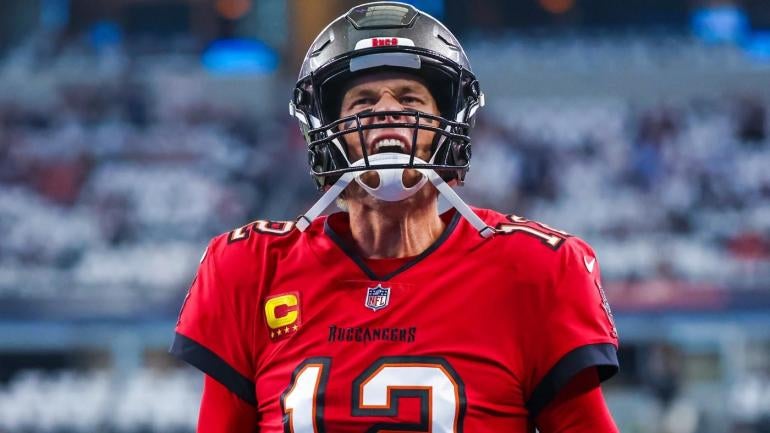
Creating the ultimate 53-man roster is pretty simple when there aren't any parameters. It's a more challenging exercise when operating under a salary cap. Roster construction becomes more complicated with other restrictions designed to prevent a squad from resembling last season's All-Pro team. The constraints bring more realism to selection process. The ground rules are as follows.
Parameters
- The salary cap for the roster is $213.489 million, although the actual NFL salary cap is $208.2 million for this year. The number being used is the league's average adjusted salary cap, according to NFLPA data. Each NFL team's working salary cap varies largely because unused cap room can be carried over from one year to the next. For example, the Jaguars have the NFL's highest adjusted salary cap at $234.92 million largely thanks to carrying over slightly more than $25.75 million of cap room, which is the most in the league. The Super Bowl LVI champion Rams have the lowest at $201.9 million, which is approximately $6.25 million below the league-wide number. Situations like this typically occur when incentives earned during the previous season that weren't counting on the cap get accounted for without sufficient cap room carrying over from the prior year to make up the difference.
- The NFL draft is an essential element of roster building for NFL teams. It is here also. One player from each round of the 2022 draft must be on the roster. The number requirement drops by one player for each year of the preceding three drafts (2019-2021). The limit of one player per round remains. Thus, only four 2019 draft picks are required. There's one other draft pick constraint: only one 2018 first-round pick whose fifth year option was exercised is allowed. Selecting one isn't a necessity. (Note: Relevant players' draft statuses can be found in parenthesis.)
- The backups at each position are limited to players who aren't established starters, were reserves in 2021 or lost a starting job this year. This means young veterans cracking the lineup for the first time are eligible as reserves. Those starting last season only because of an injury are also fair game as backups. Players competing for starting jobs in the preseason or where there's a "by committee approach" at a position, usually running back, are also acceptable. A backfield containing Derrick Henry and Jonathan Taylor is prohibited since both are workhorse or every-down running backs.
- Choosing a player who was given a franchise or transition designation in 2022 is optional. However, only one player receiving a 2022 designation can be selected.
Roster building philosophy
The initial version of the team was done without paying attention to cost. Over $250 million of cap space was used. Multiple roster adjustments were necessary in order to comply with the constraints.
There were plenty of players I would have liked to include but were luxuries who couldn't be afforded. A concerted effort was also made to keep cap numbers under $10 million. There are five selections with cap figures above $10 million.
Selecting an elite quarterback was the top priority since the NFL is a passer-driven league. A cap-friendly potential franchise quarterback is the most valuable commodity in the NFL. This is because of the roster flexibility provided by the low cap number. Choosing one was a necessity.
An emphasis was also placed on the offensive and defensive lines. The old football adage of "it starts in the trenches" was a guiding principle in assembling the roster. There are three starting cornerbacks instead of a traditional base defense (either 3-4 or 4-3) since five or more defensive backs are now used over 60% of the time in the NFL.
Long-range planning wasn't taken into account, so worrying about future salary cap obligations, the amount of cap room that could be carried over, expiring contracts and drafting players who might develop into starters down the road wasn't necessary. Different choices would have been made if these aspects had been considerations.
Here's the team I assembled with some of my thoughts behind the selections. The 2022 cap number for each player is in parentheses.
Offensive starters
QB Tom Brady, Buccaneers ($11.986 million)
Brady fits the criteria of an elite quarterback with a modest cap number. Sixteen quarterbacks have a bigger 2022 cap number than Brady's. 2020 sixth-overall pick Justin Herbert was very tempting with his $7,257,306 cap number. Selecting him would have forced a change to my starting wide receivers that I wasn't willing to make.
Brady continues to defy Father Time. The 45-year-old had one of the best seasons of his NFL career in 2021. The ageless wonder threw for a league-leading (and a career-high) 5,316 yards and 43 touchdown passes last season. His 67.5 completion percentage was the second-best mark in his career.
RB: Jonathan Taylor, Colts ($2,141,124)
Minimal resources were going to be devoted to ball carriers. That's why all of the running backs are on rookie contracts. Taylor was the no-brainer choice because of his contract and productivity. He was easily the league's best running back last season. He led the NFL with 1,811 rushing yards and 18 rushing touchdowns while averaging 5.5 yards per carry. Taylor won the rushing title by 552 yards. (2020 second round)
WR: Tyreek Hill, Dolphins ($6.485 million)
Cooper Kupp, who won the receiving triple crown last season by leading the NFL in receptions, receiving yards and receiving touchdowns, wasn't a realistic option. He has the league's third-highest wide receiver cap number at $17,807,654.
Hill is tremendous value with a $6.485 million cap number despite being the league's first $30 million per year non-QB. He's is arguably the league's most-feared deep threat because of his speed, but has also spent considerable time in the slot. According to Pro Football Focus, Hill was in the slot for 52.9% of passing snaps with the Chiefs last season.
WR: Deebo Samuel, 49ers ($6,876,519)
Samuel emerged as one of the NFL's most dangerous offensive weapons last season. He led the league with 18.2 yards per catch. Samuel caught 77 passes for 1,405 yards with six touchdowns. He was also a threat out of the backfield due to injuries to San Francisco's running backs. Samuel rushed for 365 yards on 59 carries and scored eight touchdowns on the ground. (2019 second round)
WR: Justin Jefferson, Vikings ($3,586,322)
Nobody has ever had a more productive start to an NFL career at wide receiver than Jefferson. 2020's 22nd overall pick had 196 receptions for 3,016 yards and 17 touchdowns during his first two seasons. If the Raiders hadn't made a cap maneuver in July to treat Davante Adams' $20 million 2023 roster bonus as signing bonus so it's prorated from 2022 through 2026, Jefferson wouldn't be on the team. Herbert would have gotten the 2020 first-round pick spot as quarterback. The move raised Adams's cap by $4 million from $8.18 million to $12.18 million. (2020 first round)
TE: Mark Andrews, Ravens ($9,659,676)
Andrews had one of the finest seasons ever for a tight end in 2021. He led NFL tight ends with 107 receptions and 1,361 receiving yards. His nine touchdown catches tied for the league lead among tight ends.
Andrews gets the nod over George Kittle because of durability concerns although Kittle has a lower cap number ($7,395,240). Kittle has missed eleven games over the last two seasons and began 2022 with a groin injury that kept him out of San Francisco's season opener against the Bears.
Travis Kelce getting a $3 million raise for 2022 at the start of training camp took him out of consideration. His 2022 cap number went from $8,855,882 to $11,855,882. Darren Waller's new three-year extension making him the NFL's highest-paid tight end at $17 million per year ended any chance for being on the team. He had a $6,843,750 cap number before the new deal. It's now $11.755 million.
LT: Trent Williams, 49ers ($14,031,765)
Williams was the clear-cut choice at left tackle because of a dominating 2021 season, although he has the team's second biggest cap number.
LG: Joel Bitonio, Browns ($6,658,824)
Bitonio had the best season of his career in 2021. It didn't hurt Bitonio that I had someone else in mind for fifth-year option slot besides Quenton Nelson, whose cap number is still over $10 million after becoming the league's first $20 million per year interior offensive lineman a few days ago.
C: Creed Humphrey, Chiefs ($1,274,260)
Humphrey quickly became one of the league's best centers as a rookie last season. His low cap number made him very attractive. (2021 second round)
RG: Shaq Mason, Buccaneers ($3,082,483)
Wyatt Teller, Bitonio's Cleveland counterpart, probably would have been the right guard with a $4,433,970 cap number if the Buccaneers hadn't lowered Mason's cap hit by $4.304 million recently through a contract restructure.
RT: Ryan Ramczyk, Saints ($8,483,401)
The draft choice constraints prevented Tristan Wirfs, 2020's 13th overall pick, from being the right tackle. Ramcyzk was the next best thing.

Pick Six Newsletter
Crafted By The Best NFL Experts
Get the day's big stories + fun stuff you love like mock drafts, picks and power rankings.
Thanks for signing up!
Keep an eye on your inbox.
Sorry!
There was an error processing your subscription.
Defensive starters
DE: Myles Garrett, Browns ($12,901,710)
Garrett had a career-high 16 sacks last season to rank third in the NFL. He has the third-biggest cap number on the team but is moderately priced for an elite pass rusher. By contrast, Joey Bosa and T.J Watt have $28,252,065 and $24,371,644 cap numbers, respectively.
DT: Aaron Donald, Rams ($27 million)
Donald was going to be a selection regardless of his cap number. He's gone from being known as the NFL's best non-QB to a part of the best-defensive-player-of-all-time discussions. He has the ninth-highest cap number in the league, which made roster construction more challenging.
DT: Jeffery Simmons, Titans ($4,029,376)
Simmons was unblockable in Tennessee's AFC divisional playoffs loss to the Bengals last season in which he had three sacks. (2019 first round)
DE: Von Miller, Bills ($5,151,770)
Von Miller is 33 but provides tremendous value at a fraction of Bosa and Watt's cost.
LB: Micah Parsons, Cowboys ($3,887,376)
Off-ball linebacker isn't a premium position in the NFL. Consequently, a big cap investment isn't being made.
Nobody else was considered as the 2021 first-round pick for the team. The 2021 NFL Defensive Rookie of the Year will rush the passer from inside and out in addition to playing linebacker. Parsons' 13 sacks were sixth in the NFL last season. (2021 first round)
LB: Bobby Wagner, Rams ($2,507,645)
The rebuilding Seahawks released Wagner in March rather than pay him $16.6 million this year on a $20.35 million salary cap number. Wagner is coming off a 2021 season in which he had a career high 170 tackles while earning his eighth straight Pro Bowl selection and second team All-Pro honors.
CB: Jaire Alexander, Packers ($7,076,855)
Inexpensive high-caliber cornerbacks on rookie contracts weren't really an option. Parsons prevented the inclusion of Patrick Surtain II since both are 2021 first-round picks.
There were better ways to allocate cap resources than using my 2022 first-round pick on Derek Stingley Jr., or Sauce Gardner, the third and fourth overall picks ,respectively, to be my fourth cornerback. Both have cap numbers over $6 million. A.J. Terrell would have been great with his $3,907,762 cap hit, but he is a 2020 first-round pick.
2021 was pretty much a lost season for Alexander. He was limited to four games last season because of a shoulder injury. Alexander locked up wide receivers in 2020. Opposing quarterbacks completed 50.7% of passes (35 of 69 attempts) when targeting Alexander for a 68.3 passer rating, according to PFF metrics. (2018 first round)
CB: Marshon Lattimore, Saints ($8,999,317)
Lattimore's strength is press coverage. He earned Pro Bowl honors for the third straight season in 2021.
CB: Marlon Humphrey, Ravens ($10,282,635)
There aren't a lot of the better cornerbacks who play on the outside but have also spent significant time in the slot like Humphrey. There was never going to a place for Jalen Ramsey thanks to his $23.2 million cap figure.
FS: Marcus Williams, Ravens ($4,030,950)
Alexander being the one 2018 first-round pick who had a fifth-year option exercised eliminated Minkah Fitzpatrick and Derwin James from consideration. Justin Simmons and Budda Baker were too cost prohibitive with respective $18,859,145 and $14,783,850 cap numbers. Williams is a cost effective ballhawking free safety with great range.
SS: Harrison Smith, Vikings ($7,047,058)
Smith still plays at a high level despite being 33. Smith made the Pro Bowl as a strong safety last season.
Specialists
- K: Justin Tucker, Ravens ($4,758,333)
- P: Jack Fox, Lions ($904,440)
- LS: Morgan Cox, Titans ($1,054,580)
- KR/PR: DeAndre Carter, Chargers ($1,144,145)
Tucker is the most accurate kicker in NFL history, hitting 327 of 359 field goal attempts for a 91.1% conversion rate (minimum of 100 made). He led the NFL by connecting on 94.6% of his field goal attempts (35 of 37) and didn't miss any of his 32 extra point tries last season. Tucker also set the record for the longest field goal in NFL history at 66 yards. Fox was second in the NFL in gross punting last season with a 49.2 yard average. He earned Pro Bowl honors in 2020.
Braxton Berrios, who led the NFL with 30.4 yards per kickoff return last season, was the first choice as a return man. It wasn't going to happen with a $3,776,645 cap number. Carter gets the nod quite frankly because of cost ($1,144,145 cap number) and ability to return both kicks and punts. He was third last season with 25.1 yards per kickoff return and averaged 8.4 yards per punt return. Hill may occasionally return punts since he excelled at it early in his career. Cox is a four-time Pro Bowler.
Reserves
Quarterback
- Gardner Minshew ($2,547,965)
Jimmy Garoppolo would have been the ideal backup quarterback since he has career record of 33-14 as a starter. Although he took a massive pay cut to remain with the 49ers, a $13,991,176 cap number wasn't attractive. It's almost $2.1 million more than Brady's.
Minshew checks the two boxes necessary to be Brady's backup: cheap and starting experience. The 2019-sixth round pick had started 20 of 23 NFL games he played prior to a 2021 preseason trade from the Jaguars. He acquitted himself nicely in his two starts with the Eagles last season. (2019 sixth round)
Running back
- Antonio Gibson, Commanders ($1,354,115)
- Tony Pollard, Cowboys ($1,140,547)
- Dameon Pierce, Texans ($911,966)
- Zander Horvath, Chargers ($727,805)
Gibson (2020 third round) and Pollard (2019 fourth round) will both be utilized as the third-down back. Both will get the bulk of the carries in relief of Taylor. Pollard was Dallas' most consistent and effective running back last season.
Gibson is eligible as a reserve despite being sixth in the NFL with 1,037 rushing yards last season. He had lost his starting job in the preseason. The Commanders had planned on relying on 2022 third-round pick Brian Robinson Jr. until he was a gunshot victim in an attempted robbery. He is expected back at some point this season.
Pierce (2022 fourth round) should be the Texans' leading rusher this season. Horvath (2022 seventh round) is the lone fullback. Since Horvath is primarily going to play special teams, there wasn't a need for tie up cap resources in Kyle Juszczyk or Pat Ricard at fullback. Juszczyk and Ricard's respective cap numbers are $2,960,815 and $2,198,555.
Wide receiver
- Gabe Davis, Bills ($1,078,988)
- Marquez Callaway, Saints ($907,774)
- DeAndre Carter, Chargers ($1,144,145)
The coming out party for Davis (2020 fourth round) was in last season's playoffs after being Buffalo's fourth wide receiver during the regular season. He had eight catches for 201 yards and a playoff record four receiving touchdowns against the Chiefs. Callaway was the Saints' leading wide receiver by default in 2021 with Michael Thomas missing the season because of an ankle injury. His opportunities are going to be limited this season with Thomas returning and the addition of Jarvis Landry in free agency and Chris Olave in the draft. Carter's biggest contribution will be returning kicks.
Tight end
- Maxx Williams, Cardinals ($996,940)
- Brevin Jordan, Texans ($921,896)
Williams is primarily a blocking tight end. He has having the best season of his career in 2021 when he tore an ACL, which prompted the Cardinals to trade for Zach Ertz. Jordan (2021 fifth round) started saw increased action during the second half of the 2021 season, which should continue this season.
Offensive line
- T: Cornelius Lucas, Commanders ($2.67 Million)
- G/T: Mike Onwenu, Patriots ($953,877)
- G/T: Brady Christensen, Panthers ($1,173,413)
- C: Ethan Pocic, Browns ($1,196,055)
The offensive line depth is a mix of experience and youth with versatility. Lucas is the swing tackle. There wasn't much of a drop off when right tackle Samuel Cosmi was injured last season. Onwenu (2020 sixth round) became New England's sixth lineman in 2021 when Trent Brown returned from injury to right tackle. He was originally slated to be the left guard but the Patriots stuck with Ted Karras, who took over for him while he was filling in for Brown. Karras leaving in free agency and Mason being traded has put Onwenu back in New England's lineup at right guard. Christensen (2021 third round) can play both guard and tackle on either side. Pocic had been the Seahawks' starting center the last two seasons before signing a one-year deal worth up to a maximum of $1.5 million in Cleveland.
Defensive tackle
- Morgan Fox, Chargers ($1,051,040)
- Quinton Bohanna, Cowboys ($880,674)
Fox reprises the understudy role to Donald that he had during his first four NFL seasons (2016 to 2020). Bohanna (2021 sixth round) is strictly a run stuffer.
Defensive End
- George Karlaftis, Chiefs ($2,172,454)
- Rashad Weaver, Titans ($993,356)
- Dominique Robinson, Bears ($776,840)
Good veteran situational pass rushers aren't cheap, so I went with players on rookie contracts. Karlaftis (2022 first round) should give Kansas City's pass rush a boost. Weaver (2021 fourth round) missed most of last season with a broken right leg. The Titans are counting on him since Harold Landry, who had 12 sacks in 2021, is out for the season with a torn ACL. Robinson (2022 fifth round) may prove to be a draft steal for the Bears.
Linebacker
- Cody Barton, Seahawks ($1,194,881)
- Jayon Brown, Raiders ($1,223,400)
- Alex Singleton, Broncos ($1,124,470)
- Malcolm Rodriguez, Lions ($755,682)
Barton (2019 third round) is Wagner's replacement in Seattle. Brown and Singleton fell out of favor with their previous teams, the Titans and Eagles, after being starters at various points. Rodriguez (2022 sixth round) has been a pleasant surprise in Detroit. Barton, Brown, Singleton and Rodriguez are core special teams players on this squad.
Cornerback
- Ahkello Witherspoon, Steelers ($2,521,040)
- Martin Emerson, Browns ($998,480)
- Dane Jackson, Bills ($904,145)
Witherspoon played reasonably well down the stretch in 2021 for Pittsburgh after being inactive for most of the first half of the season. Jackson (2020 seventh round) is going to see his share of number one wide receivers until Tre'Davious White returns from the left ACL tear he suffered late last season. Emerson (2022 third round) was one of the more impressive rookies during the preseason.
Safety
- Jaquan Brisker, Bears ($1,340,923)
- Duron Harmon, Raiders ($1,047,500)
Brisker should be a candidate for All-Rookie honors. Harmon is a veteran who can play either free or strong safety.
Tale of the tape
- Total salary cap room used (53 Players): $208,517,016
- Remaining salary cap room: $4,971,984
- Offense (25 Players): $91,900,086
- Defense (25 Players): $109,899,577
- Specialists (3 Players): $6,717,353
Positional salary breakdown
(Salary cap percentage in parentheses)
- QB: $14,443,965 (6.77%)
- RB: $6,275,557 (2.94%)
- WR: $20,078,748 (9.41%)
- TE: $11,578,512 (5.42%)
- OL: $39,524,078 (18.51%)
- DT: $32,961,090 ($15.44%)
- DE: $21,996,130 (10.3%)
- LB: $10,693,454 (5.01%)
- CB: $30,782,472 (14.42%)
- S: $13,466,431 (6.31%)
Final thoughts
All of the cap room isn't being used. A cushion has been left for a full practice squad of 16 players (approximately $3.5 million) and to sign players when the inevitable injuries happen during the season.
There is a bigger allocation of cap resources to defense, which should be expected with a low-cost starting quarterback. Nearly 45% of the available cap space is devoted to the offensive and defensive lines, which is consistent with the "starting in the trenches" philosophy.
The Browns and Ravens lead the way with four players each. Six teams (Bengals Falcons, Giants, Jaguars and Jets) didn't have a player selected. The AFC Champion Bengals not having any players is surprising.






